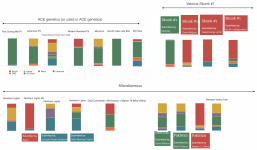Lebanizer
Well-known member
A question for dubi , if you find the time to answer I'd be grateful.
First, I want to say I love what ACE has accomplished and has a lot of respect for your philosophy and your work.
Until recently I had never bothered to click on the rainbow circle that appears on some strain description which points to the phylos project. When I did, I was very surprised to see skunk listed in some genetics. Now if we bear in mind that Skunk is 25% Afghan and 75% South American (50% Mexican + 25% Columbian), in some cases there's nothing shocking about seeing skunk genetics being reported. For instance, in South American strains such as Panama, Honduras or even Tikal, it makes total sense as we can expect Panama, Honduras and Guatemala to be close to Columbian and therefore to overlap with skunk genetic markers. In the case of Tikal we can even add the Kush element in relation to the Afghan part of the skunk genetic. Again nothing shocking here.
For other strains however this is much more surprising. In particular, in the case of Malawi and China Yunnan (and Orient Express) or Bangi Haze (Congo x Nepal), it is quite confusing to find skunk genetics reported as one would expect them to be completely unrelated. Do you knwo how such an overlap could happen ?
Again I'm not trying to stir controversy at all but some results are very surprising.
In any case, thanks for any light you can shed on those surprising readings.
First, I want to say I love what ACE has accomplished and has a lot of respect for your philosophy and your work.
Until recently I had never bothered to click on the rainbow circle that appears on some strain description which points to the phylos project. When I did, I was very surprised to see skunk listed in some genetics. Now if we bear in mind that Skunk is 25% Afghan and 75% South American (50% Mexican + 25% Columbian), in some cases there's nothing shocking about seeing skunk genetics being reported. For instance, in South American strains such as Panama, Honduras or even Tikal, it makes total sense as we can expect Panama, Honduras and Guatemala to be close to Columbian and therefore to overlap with skunk genetic markers. In the case of Tikal we can even add the Kush element in relation to the Afghan part of the skunk genetic. Again nothing shocking here.
For other strains however this is much more surprising. In particular, in the case of Malawi and China Yunnan (and Orient Express) or Bangi Haze (Congo x Nepal), it is quite confusing to find skunk genetics reported as one would expect them to be completely unrelated. Do you knwo how such an overlap could happen ?
Again I'm not trying to stir controversy at all but some results are very surprising.
In any case, thanks for any light you can shed on those surprising readings.
Last edited:



